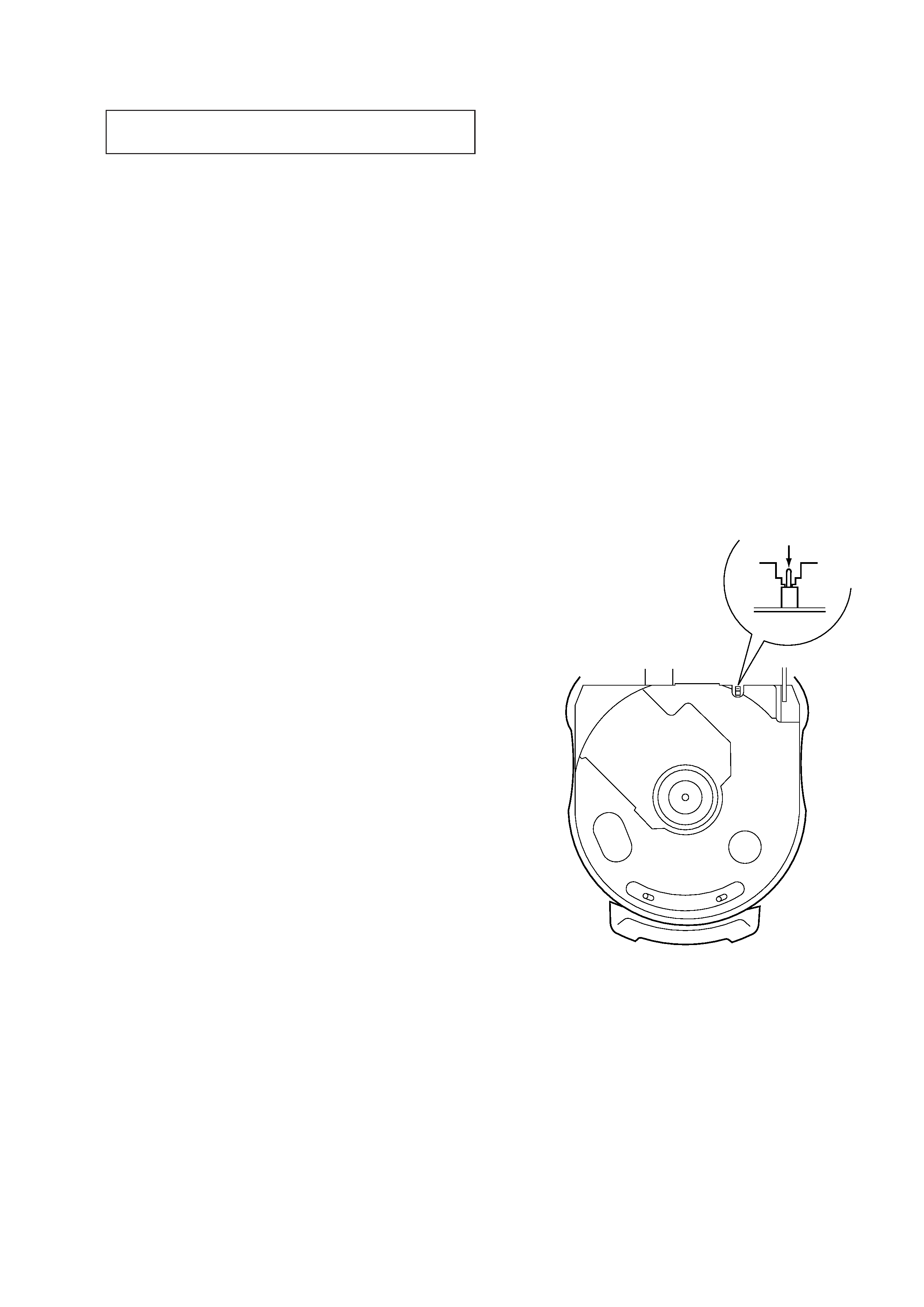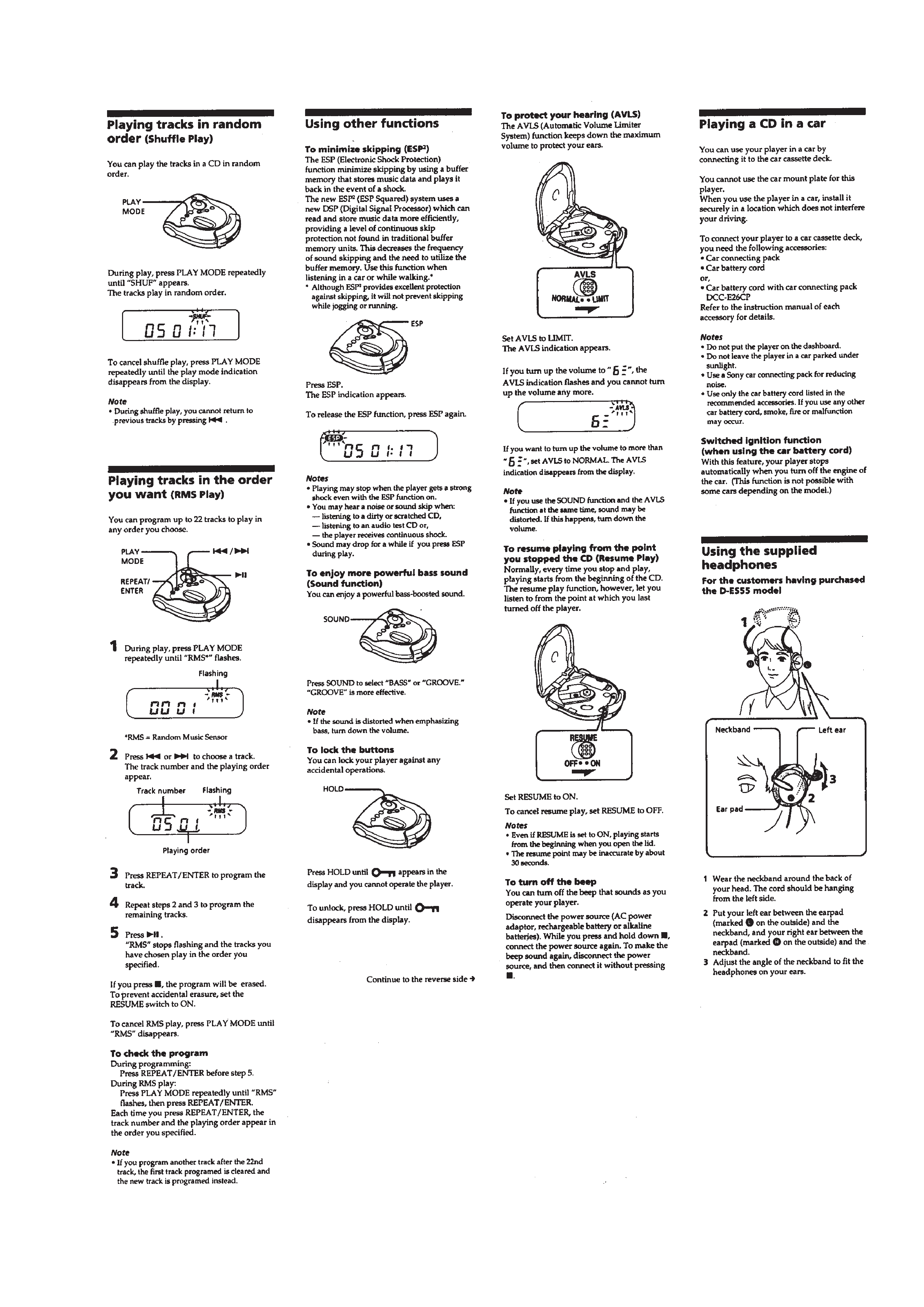
MICROFILM
SERVICE MANUAL
COMPACT DISC COMPACT PLAYER
US Model
Canadian Model
AEP Model
UK Model
E Model
Australian Model
SPECIFICATIONS
D-ES51/ES55
Photo: D-ES55
Model Name Using Similar Mechanism
NEW
CD Mechanism Type
CDM-2801AAA
Optical Pick-Up Name
DAX-01A2
System
Compact disc digital audio system
Laser diode properties
Material: GaAlAs
Wavelength:
= 780 nm
Emission duration: Continuous
Laser output: Less than 44.6 µW
(This output is the value measured at a distance of 200 mm from the
objective lens surface on the optial pick-up block with 7 mm
aperture.)
Error correction
Sony Super Strategy Cross Interleave Reed Solomon Code
D-A conversion
1-bit quartz time-axis control
Frequency response
20 20,000 Hz
dB (measured by EIAJ CP-307)
Output (at 4.5 V input level)
Headphones (stereo minijack)
15 mW + 15 mW at 16 ohms
General
Power requirements
For the area code of the model you purchased, check the upper left
side of the bar code on the package.
· Sony BP-DM10 Rechargeable battery:
2.4 V DC, Ni-Cd, 650 mAh
· Two LR6 (size AA) batteries: 3 V DC
· AC power adaptor (DC IN 4.5 V jack):
US, Canadian, E92 model: 120 V, 60 Hz
AEP, French, E13 model: 220 230 V, 50/60 Hz
UK model: 230 240 V, 50 Hz
Australian model: 240 V, 50 Hz
Dimensions (w/h/d) (without projecting parts and controls)
Approx. 138.3
× 34.3 × 145.8 mm
(51/2
× 13/8 × 53/4 in.)
Mass (without rechargeable batteries)
Approx. 312 g (11.1oz)
Operating temperature
5°C 35°C (41°F 95°F)
-- Continued on next page --
+1
2
Ver 1.1 1998. 07

2
Flexible Circuit Board Repairing
· Keep the temperature of the soldering iron around 270 °C dur-
ing repairing.
· Do not touch the soldering iron on the same conductor of the
circuit board (within 3 times).
· Be careful not to apply force on the conductor when soldering
or unsoldering.
Notes on chip component replacement
· Never reuse a disconnected chip component.
· Notice that the minus side of a tantalum capacitor may be dam-
aged by heat.
ATTENTION AU COMPOSANT AYANT RAPPORT
À LA SÉCURITÉ!
LES COMPOSANTS IDENTIFIÉS PAR UNE MARQUE
!
SUR LES DIAGRAMMES SCHÉMATIQUES ET LA LISTE
DES PIÈCES SONT CRITIQUES POUR LA SÉCURITÉ
DE FONCTIONNEMENT. NE REMPLACER CES COM-
POSANTS QUE PAR DES PIÈCES SONY DONT LES
NUMÉROS SONT DONNÉS DANS CE MANUEL OU
DANS LES SUPPLÉMENTS PUBLIÉS PAR SONY.
SAFETY-RELATED COMPONENT WARNING!!
COMPONENTS IDENTIFIED BY MARK
! OR DOTTED
LINE WITH MARK
! ON THE SCHEMATIC DIAGRAMS
AND IN THE PARTS LIST ARE CRITICAL TO SAFE
OPERATION. REPLACE THESE COMPONENTS WITH
SONY PARTS WHOSE PART NUMBERS APPEAR AS
SHOWN IN THIS MANUAL OR IN SUPPLEMENTS PUB-
LISHED BY SONY.
CAUTION
Use of controls or adjustments or performance of procedures
other than those specified herein may result in hazardous ra-
diation exposure.
This appliance is classified as a CLASS 1 LASER product.
The CLASS 1 LASER PRODUCT MARKING is located on
the rear exterior.
Supplied accessories
For the area code of the model you purchased, check the upper left side
of the bar code on the package.
D-ES51
AC power adaptor (1)
AC plug adaptor (1)*
Stereo headphones (1)
* Supplied with E13 model
D-ES55
AC power adaptor (1)
AC plug adaptor (1)*
Stereo headphones (1)
Rechargeable batteries (1)**
* Supplied with E13 model
**Supplied with US model only
Design and specifications are subject to change without notice.
· Abbreviation
E13: 220 230 V AC area
E92: 120 V AC area
TABLE OF CONTENTS
1.
SERVICING NOTES ............................................... 3
2.
GENERAL ................................................................... 4
3.
DISASSEMBLY ......................................................... 7
4.
SERVICE MODE ...................................................... 10
5.
ELECTRICAL ADJUSTMENTS ......................... 11
6.
DIAGRAMS
6-1. Block Diagram ................................................................ 13
6-2. Printed Wiring Boards .................................................... 17
6-3. Schematic Diagram ......................................................... 21
6-4. IC Pin Function Description ........................................... 33
7.
EXPLODED VIEWS ................................................ 35
8.
ELECTRICAL PARTS LIST ............................... 38

3
SECTION 1
SERVICING NOTES
NOTES ON HANDLING THE OPTICAL PICK-UP
BLOCK OR BASE UNIT
The laser diode in the optical pick-up block may suffer electro-
static breakdown because of the potential difference generated by
the charged electrostatic load, etc. on clothing and the human body.
During repair, pay attention to electrostatic breakdown and also
use the procedure in the printed matter which is included in the
repair parts.
The flexible board is easily damaged and should be handled with
care.
NOTES ON LASER DIODE EMISSION CHECK
The laser beam on this model is concentrated so as to be focused
on the disc reflective surface by the objective lens in the optical
pick-up block. Therefore, when checking the laser diode emis-
sion, observe from more than 30 cm away from the objective lens.
Befor Replacing the Optical Pick-Up Block
Please be sure to check thoroughly the parameters as par the "Op-
tical Pick-Up Block Checking Procedures" (Part No.: 9-960-027-
11) issued separately before replacing the optical pick-up block.
Note and specifications required to check are given below.
· FOK output: IC501 !TM pin
When checking FOK, remov the lead wire to disc motor.
· S curve P-to-P value: 0.6 - 1.8 Vp-p IC501 #¡ pin
When checking S curve P-to-P value, remove the lead wire to
disc motor.
· RF signal P-to-P value: 0.8 - 1.2 Vp-p
· Traverse signal P-to-P value: 1.2 Vp-p
· The repairing grating holder is impossible.
Precautions for Checking Emission of Laser Diode
Laser light of the equipment is focused by the object lens in the
optical pick-up so that the light focuses on the reflection surface
of the disc. Therefore, be sure to keep your eyes more then 30 cm
apart from the object lens when you check the emission of laser
diode.
Laser Diode Checking Methods
During normal operation of the equipment, emission of the laser
diode is prohibited unless the upper panel is closed while turning
ON the S801 (push switch type).
The following two checking methods for the laser diode are oper-
able.
· Method (In the service mode or normal operation):
Emission of the laser diode is visually checked.
1. Open the upper lid.
2. Push the S801 as shown in Fig. 1.
3. Press the
^ key.
4. Check the object lens for confirming normal emission of the
laser diode. If not emitting, there is a trouble in the automatic
power control circuit or the optical pick-up.
During normal operation, the laser diode is turned ON about
2.5 seconds for focus searching.
Fig. 1 Method to push the S801
S801

4
SECTION 2
GENERAL
This section is extracted from
instruction manual.

5
